Design and SAR Analysis of a Dual Band Wearable Antenna for WLAN Applications
Abstract
:1. Introduction
2. Design Methodology
2.1. Conventional Approach
2.2. Metamaterial Based Approach
2.2.1. Dual Band EBG Unit Cells
2.2.2. Electromagnetic Band-Gap Array
2.3. EBG-Based Antenna
2.4. Human Phantom Modeling
3. Results
3.1. Off-Body Analysis
3.1.1. Conventional Antenna
3.1.2. Metamaterial-Based Antenna
3.1.3. Conventional Antenna in Different Free Space Bending Conditions
3.2. On-Body Analysis
3.2.1. Return Loss
3.2.2. Directivity and Gain Patterns
3.3. Specific Absorption Rate (SAR) Analysis of Conventional Dual Band Antenna
4. Conclusions
Author Contributions
Funding
Institutional Review Board Statement
Informed Consent Statement
Data Availability Statement
Conflicts of Interest
References
- Xiangfang, R.; Lei, S.; Miaomiao, L.; Xiying, Z.; Han, C. Research and sustainable design of wearable sensor for clothing based on body area network. Cogn. Comput. Syst. 2021, 3, 206–220. [Google Scholar] [CrossRef]
- Ali, S.M.; Sovuthy, C.; Imran, M.A.; Socheatra, S.; Abbasi, Q.H.; Abidin, Z.Z. Recent advances of wearable antennas in materials, fabrication methods, designs, and their applications: State-of-the-art. Micromachines 2020, 11, 888. [Google Scholar] [CrossRef] [PubMed]
- Elsheakh, D.M.; Abdallah, E.A. Different feeding techniques of microstrip patch antennas with spiral defected ground structure for size reduction and ultra-wide band operation. J. Electromagn. Anal. Appl. 2012, 4, 410–418. [Google Scholar] [CrossRef]
- Fallahpour, M.; Zoughi, R. Antenna miniaturization techniques: A review of topology-and material-based methods. IEEE Antennas Propag. Mag. 2017, 60, 38–50. [Google Scholar] [CrossRef]
- Ahmad, A.; Arshad, F.; Naqvi, S.I.; Amin, Y.; Tenhunen, H.; Loo, J. Flexible and compact spiral-shaped frequency reconfigurable antenna for wireless applications. IETE J. Res. 2020, 66, 22–29. [Google Scholar] [CrossRef]
- Mahfuz, M.H.; Islam, M.R.; Park, C.W.; Elsheikh, E.A.; Suliman, F.; Habaebi, M.H.; Malek, N.A.; Sakib, N. Wearable Textile Patch Antenna: Challenges and Future Directions. IEEE Access 2022, 10, 38406–38427. [Google Scholar] [CrossRef]
- Ali, U.; Ullah, S.; Khan, J.; Shafi, M.; Kamal, B.; Basir, A.; Flint, J.A.; Seager, R.D. Design and SAR analysis of wearable antenna on various parts of human body, using conventional and artificial ground planes. J. Electr. Eng. Technol. 2017, 12, 317–328. [Google Scholar] [CrossRef]
- Augustine, R.; Alves, T.; Sarrebourse, T.; Poussot, B.; Mathew, K.; Laheurte, J.M. Polymeric ferrite sheets for SAR reduction of wearable antennas. Electron. Lett. 2010, 46, 197. [Google Scholar] [CrossRef]
- Augustine, R.; Alves, T.; Zhadobov, M.; Poussot, B.; Sarrebourse, T.; Sauleau, R.; Thomas, M.K.; Laheurte, J.M. SAR reduction of wearable antennas using polymeric ferrite sheets. In Proceedings of the Fourth European Conference on Antennas and Propagation, Barcelona, Spain, 12–16 April 2010; pp. 1–3. [Google Scholar]
- Jensen, M.A.; Rahmat-Samii, Y. EM interaction of handset antennas and a human in personal communications. Proc. IEEE 1995, 83, 7–17. [Google Scholar] [CrossRef]
- Li, H.; Tsiaras, A.; Lau, B.K. Analysis and estimation of MIMO-SAR for multi-antenna mobile handsets. IEEE Trans. Antennas Propag. 2017, 65, 1522–1527. [Google Scholar] [CrossRef] [Green Version]
- Ramachandran, T.; Faruque, M.R.I.; Islam, M.T. Specific absorption rate reduction for sub-6 frequency range using polarization dependent metamaterial with high effective medium ratio. Sci. Rep. 2022, 12, 1–18. [Google Scholar] [CrossRef] [PubMed]
- Ramachandran, T.; Faruque, M.R.I.; Ahamed, E.; Abdullah, S. Specific absorption rate reduction of multi split square ring metamaterial for L-and S-band application. Results Phys. 2019, 15, 102668. [Google Scholar] [CrossRef]
- Mallik, A.; Kundu, S.; Goni, M.O. Gain and SAR improvement of a conventional patch antenna using a novel Pi-shaped DNG metamaterial. In Proceedings of the 2013 International Conference on Electrical Information and Communication Technology (EICT), Khulna, Bangladesh, 13–15 February 2014; pp. 1–6. [Google Scholar]
- Janapala, D.K.; Nesasudha, M.; Neebha, T.M.; Kumar, R. Specific absorption rate reduction using metasurface unit cell for flexible polydimethylsiloxane antenna for 2.4 GHz wearable applications. Int. J. RF Microw.-Comput.-Aided Eng. 2019, 29, e21835. [Google Scholar] [CrossRef]
- Islam, M.T.; Faruque, M.R.I.; Misran, N. Reduction of specific absorption rate (SAR) in the human head with ferrite material and metamaterial. Prog. Electromagn. Res. C 2009, 9, 47–58. [Google Scholar] [CrossRef]
- Potey, P.M.; Tuckley, K. Design of wearable textile antenna for low back radiation. J. Electromagn. Waves Appl. 2020, 34, 235–245. [Google Scholar] [CrossRef]
- Song, L.; Rahmat-Samii, Y. A systematic investigation of rectangular patch antenna bending effects for wearable applications. IEEE Trans. Antennas Propag. 2018, 66, 2219–2228. [Google Scholar] [CrossRef]
- El May, W.; Sfar, I.; Ribero, J.M.; Osman, L. A millimeter-wave textile antenna loaded with EBG structures for 5G and IoT applications. In Proceedings of the 2019 IEEE 19th Mediterranean Microwave Symposium (MMS), Hammamet, Tunisia, 31 October–2 November 2019; pp. 1–4. [Google Scholar]
- Harine, G.; Abirami, S.; Harini, B.; Florence, S.E.; Subramaniam, I. Design and Analysis of Novel EBG/AMC Unit Cell. In Proceedings of the 2019 5th International Conference on Advanced Computing & Communication Systems (ICACCS), Coimbatore, India, 15–16 March 2019; pp. 684–688. [Google Scholar]
- Rano, D.; Hashmi, M. Extremely compact EBG-backed antenna for smartwatch applications in medical body area network. IET Microwaves, Antennas Propag. 2019, 13, 1031–1040. [Google Scholar] [CrossRef]
- Zu, H.; Wu, B.; Yang, P.; Li, W.; Liu, J. Wideband and High-Gain Wearable Antenna Array with Specific Absorption Rate Suppression. Electronics 2021, 10, 2056. [Google Scholar] [CrossRef]
- Ahmad, A.; Choi, D.y.; Ullah, S. A compact two elements MIMO antenna for 5G communication. Sci. Rep. 2022, 12, 1–8. [Google Scholar] [CrossRef]
- Chen, X.; Zhang, S.; Li, Q. A review of mutual coupling in MIMO systems. IEEE Access 2018, 6, 24706–24719. [Google Scholar] [CrossRef]
- Mohamadzade, B.; Lalbakhsh, A.; Simorangkir, R.B.; Rezaee, A.; Hashmi, R.M. Mutual coupling reduction in microstrip array antenna by employing cut side patches and EBG structures. PRogress Electromagn. Res. M 2020, 89, 179–187. [Google Scholar] [CrossRef]
- Khan, A.; Bashir, S.; Ghafoor, S.; Qureshi, K.K. Mutual coupling reduction using ground stub and EBG in a compact wideband MIMO-antenna. IEEE Access 2021, 9, 40972–40979. [Google Scholar] [CrossRef]
- Acharjee, J.; Mandal, K.; Mandal, S.K. Reduction of mutual coupling and cross-polarization of a MIMO/diversity antenna using a string of H-shaped DGS. AEU-Int. J. Electron. Commun. 2018, 97, 110–119. [Google Scholar] [CrossRef]
- Trivedi, K.; Pujara, D. Mutual coupling reduction using defected ground structure in UWB DRA array for MIMO application. In Proceedings of the 2020 IEEE International Symposium on Antennas and Propagation and North American Radio Science Meeting, Montreal, QC, Canada, 5–10 July 2020; pp. 1879–1880. [Google Scholar]
- Ahmad, U.; Ullah, S.; Rafique, U.; Choi, D.Y.; Ullah, R.; Kamal, B.; Ahmad, A. MIMO Antenna System With Pattern Diversity for Sub-6 GHz Mobile Phone Applications. IEEE Access 2021, 9, 149240–149249. [Google Scholar] [CrossRef]
- Hossain, M.; Faruque, M.R.I.; Islam, M.T. Analysis on the effect of the distances and inclination angles between human head and mobile phone on SAR. Prog. Biophys. Mol. Biol. 2015, 119, 103–110. [Google Scholar] [CrossRef]
- Yalduz, H.; Tabaru, T.E.; Kilic, V.T.; Turkmen, M. Design and analysis of low profile and low SAR full-textile UWB wearable antenna with metamaterial for WBAN applications. AEU-Int. J. Electron. Commun. 2020, 126, 153465. [Google Scholar] [CrossRef]
- Abbas, S.M.; Ranga, Y.; Esselle, K.P. Sensitivity of a wearable printed antenna with a full ground plane in close proximity to human arm. In Proceedings of the 2015 9th European Conference on Antennas and Propagation (EuCAP), Lisbon, Portugal, 12–17 April 2015; pp. 1–4. [Google Scholar]
- Elias, N.; Samsuri, N.; Rahim, M. Analytical study of energy absorption in human body due to bendable behaviour of textile antenna. In Theory and Applications of Applied Electromagnetics; Springer: Berlin/Heidelberg, Germany, 2015; pp. 329–337. [Google Scholar]
- Pandimadevi, M.; Tamilselvi, R.; Parisa Beham, M. Design and simulation of flexible jute antenna with performance validation on bending and soaking conditions. Text. Res. J. 2021, 91, 219–231. [Google Scholar] [CrossRef]
- Balanis, C.A. Antenna Theory: Analysis and Design; John Wiley & Sons: Hoboken, NJ, USA, 2015. [Google Scholar]
- Ahmad, A.; Faisal, F.; Khan, S.; Ullah, S.; Ali, U. Performance analysis of a wearable and dual band planar antenna using a mushroom-like electromagentic bandgap (EBG) ground plane. In Proceedings of the 2015 International Conference on Open Source Systems & Technologies (ICOSST), Lahore, Pakistan, 17–19 December 2015; pp. 24–29. [Google Scholar]
- Faisal, F.; Ahmad, A.; Ali, U.; Ullah, S.; Ullah, K. Performance analysis of a 2.4 GHz planar antenna using different types of wearable artificial ground planes. In Proceedings of the 2015 12th International Conference on High-capacity Optical Networks and Enabling/Emerging Technologies (HONET), Islamabad, Pakistan, 21–23 December 2015; pp. 1–5. [Google Scholar]
- Saraereh, O.A. Microstrip wearable dual-band antenna design for ON body wireless communications. In Proceedings of the 2019 IEEE 4th International Conference on Computer and Communication Systems (ICCCS), Singapore, 23–25 February 2019; pp. 585–589. [Google Scholar]
- Hasan, M.; Faruque, M.R.I.; Islam, M.T. Dual band metamaterial antenna for LTE/bluetooth/WiMAX system. Sci. Rep. 2018, 8, 1–17. [Google Scholar] [CrossRef]
- Sankaralingam, S.; Gupta, B. Development of textile antennas for body wearable applications and investigations on their performance under bent conditions. Prog. Electromagn. Res. B 2010, 22, 53–71. [Google Scholar] [CrossRef]
- International Commission on Non-Ionizing Radiation Protection (ICNIRP). Guidelines for limiting exposure to electromagnetic fields (100 kHz to 300 GHz). Health Phys. 2020, 118, 483–524. [Google Scholar] [CrossRef]
- Bailey, W.H.; Bodemann, R.; Bushberg, J.; Chou, C.K.; Cleveland, R.; Faraone, A.; Foster, K.R.; Gettman, K.E.; Graf, K.; Harrington, T.; et al. Synopsis of IEEE Std C95. 1™-2019 “IEEE Standard for Safety Levels With Respect to Human Exposure to Electric, Magnetic, and Electromagnetic Fields, 0 Hz to 300 GHz”. IEEE Access 2019, 7, 171346–171356. [Google Scholar] [CrossRef]
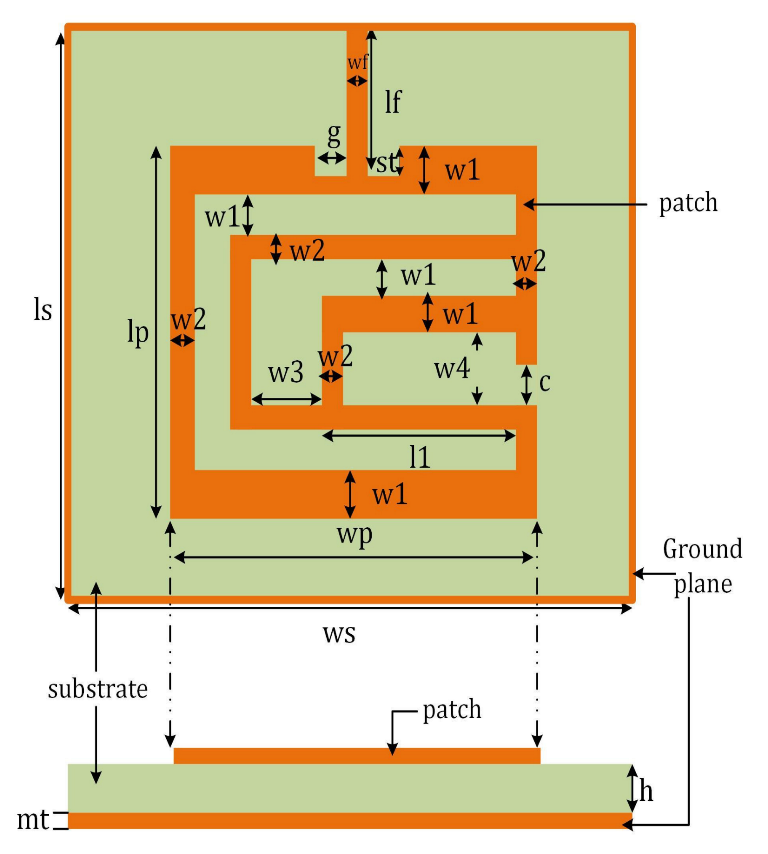

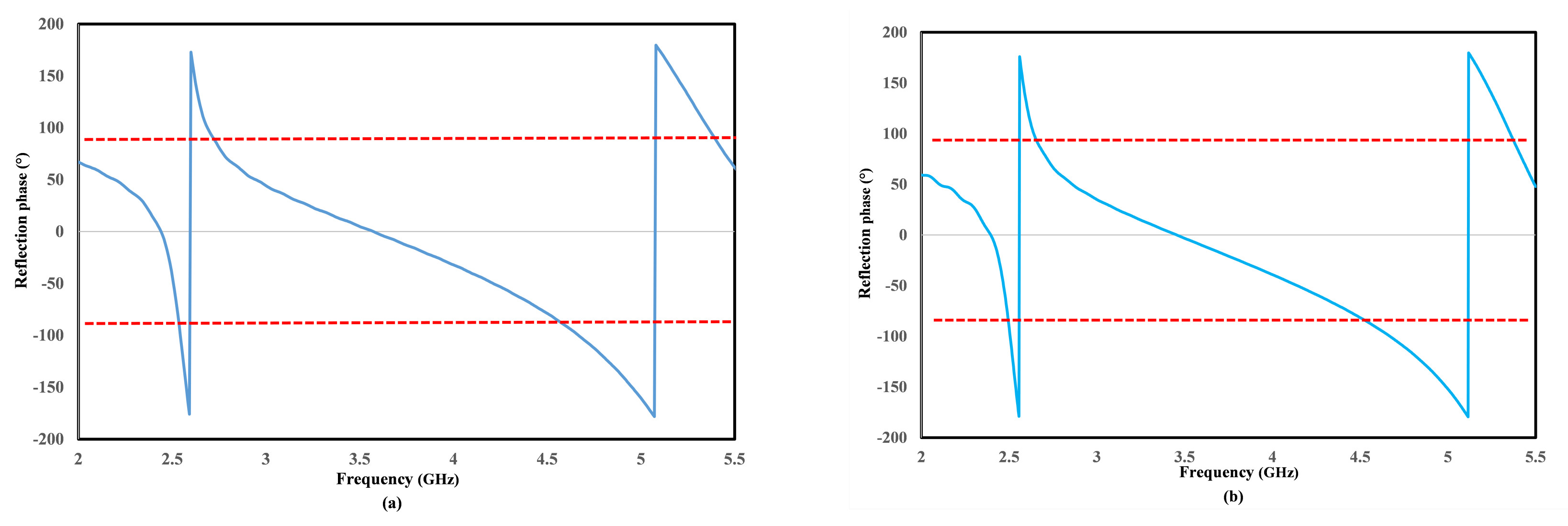


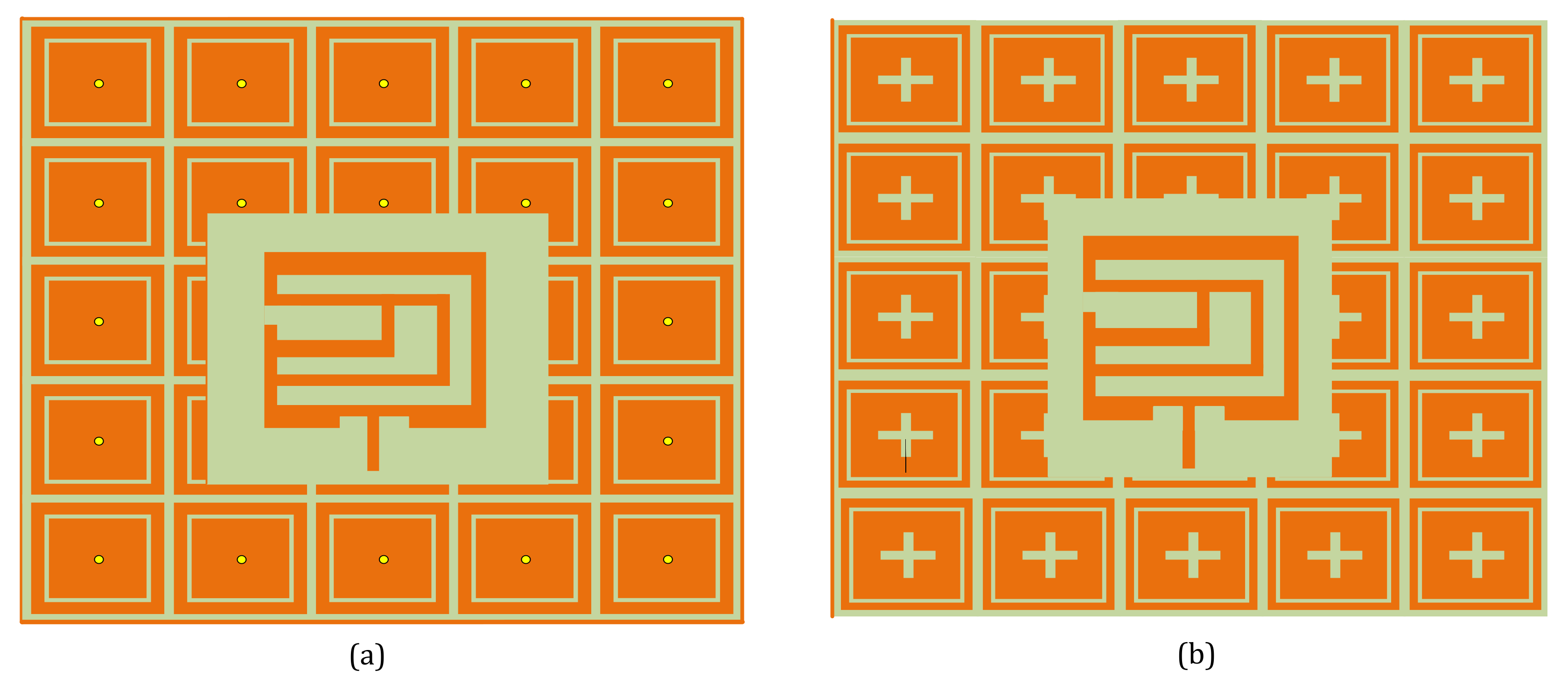
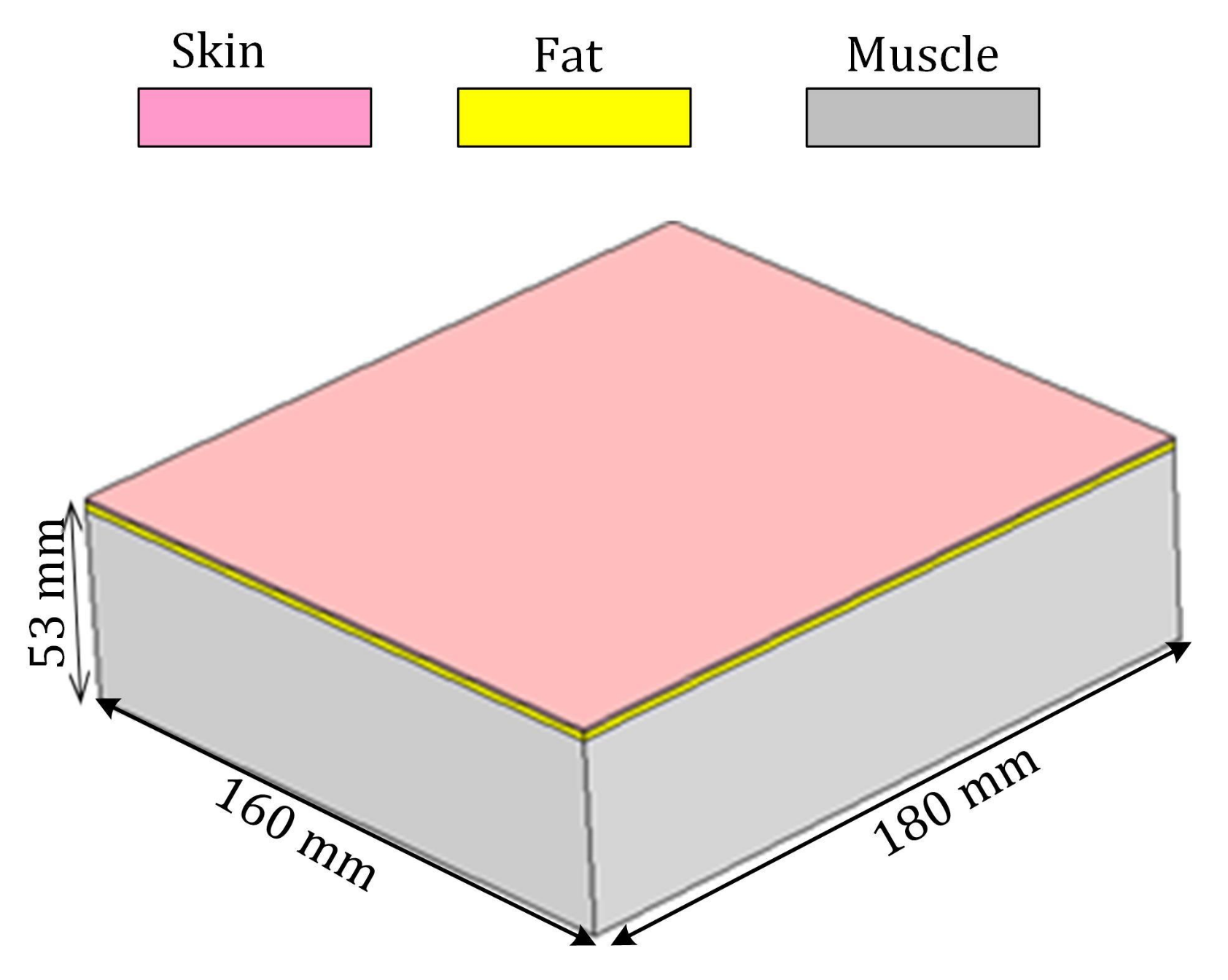
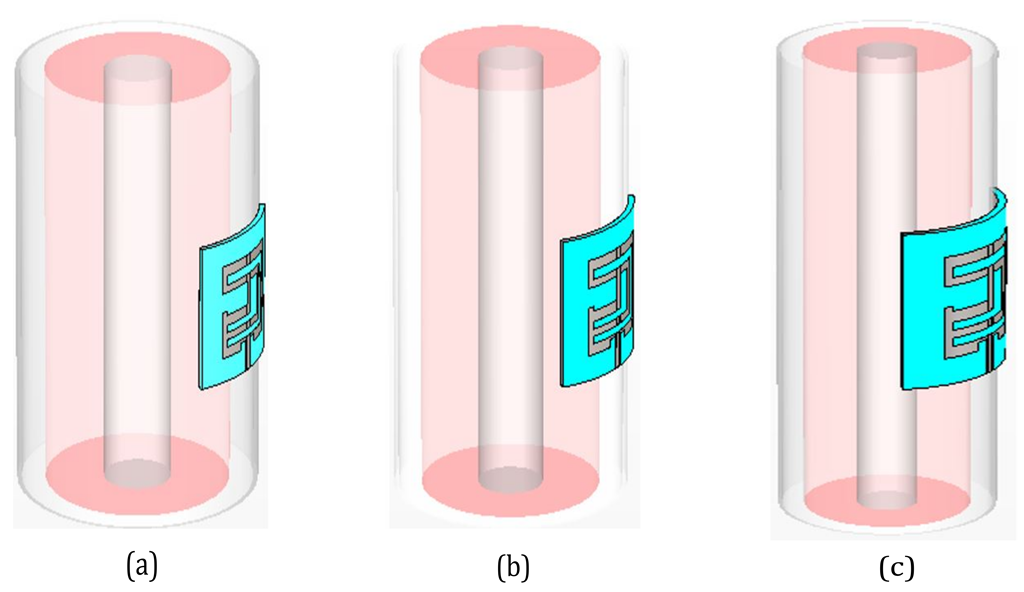
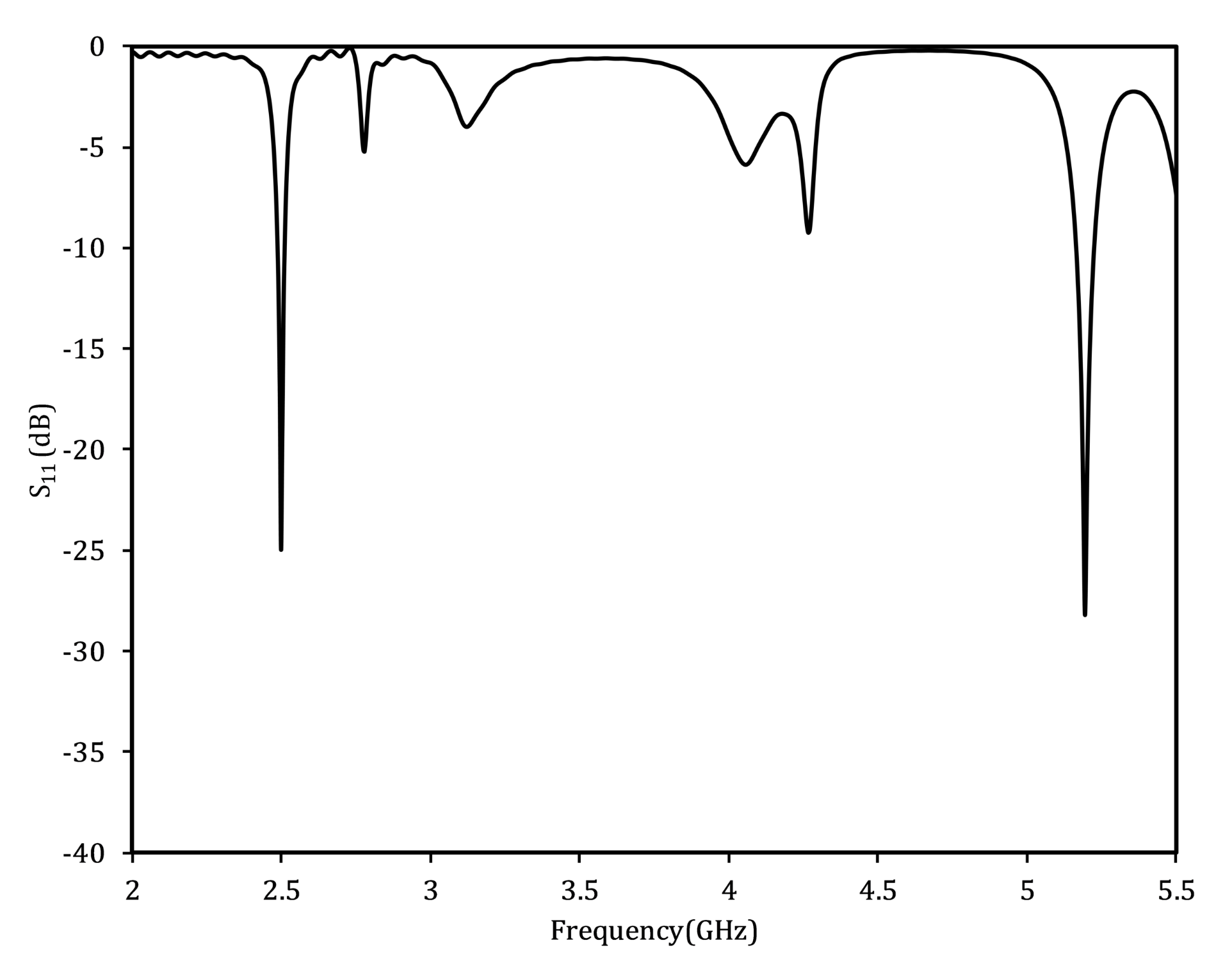
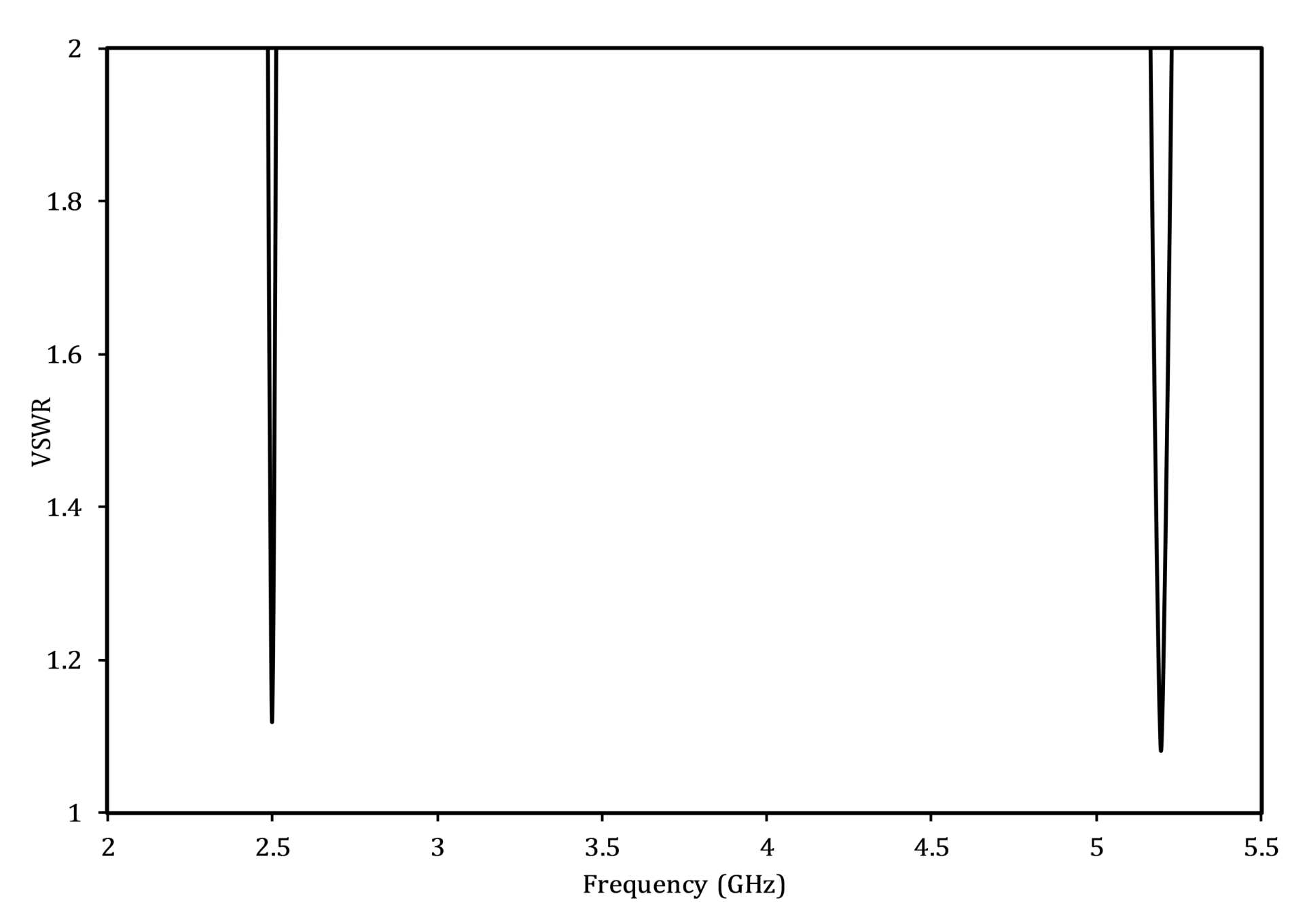
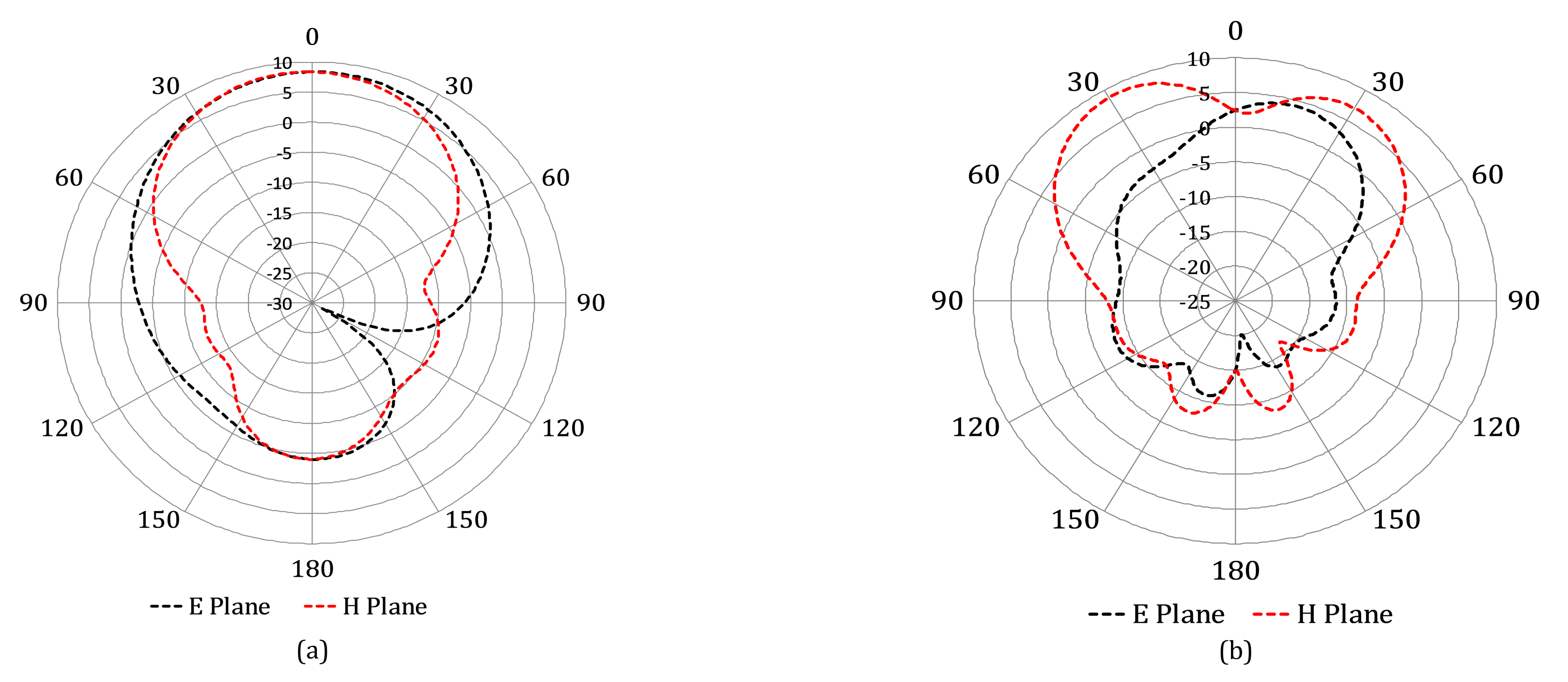
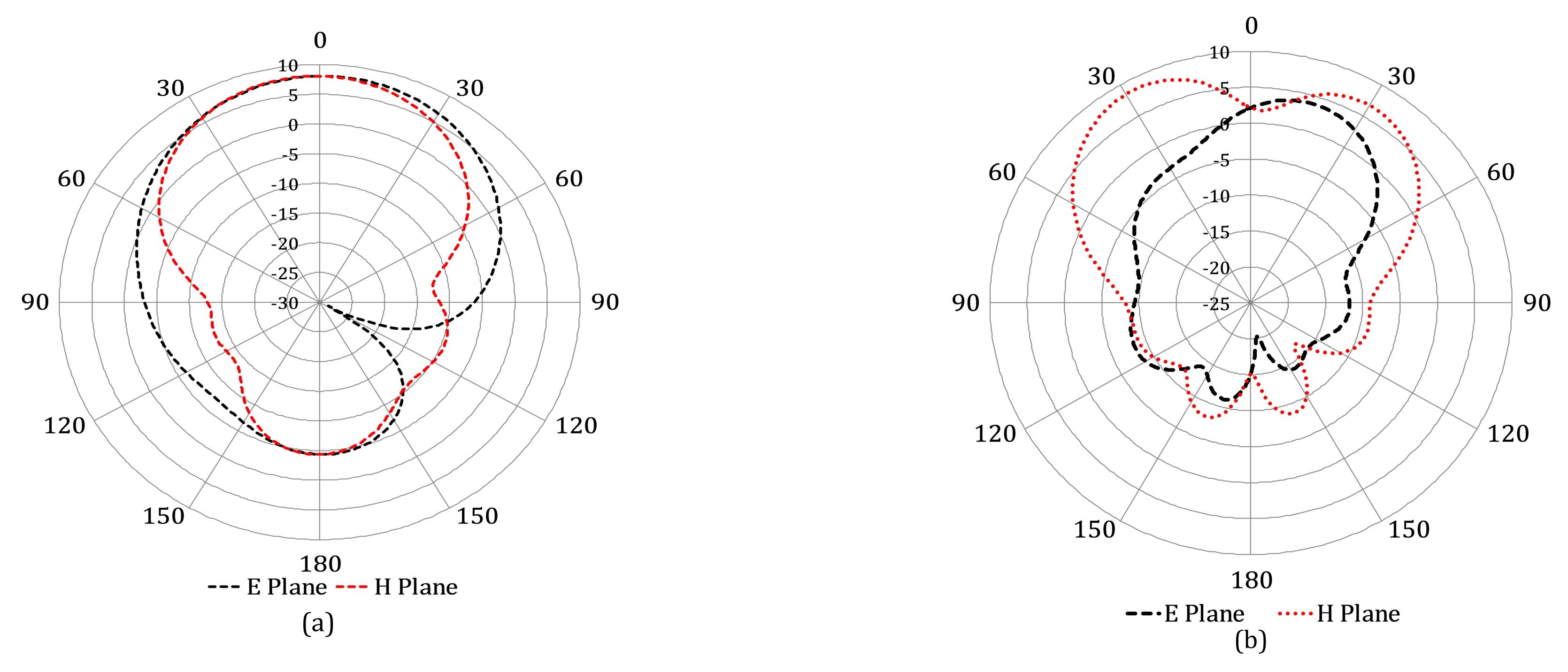
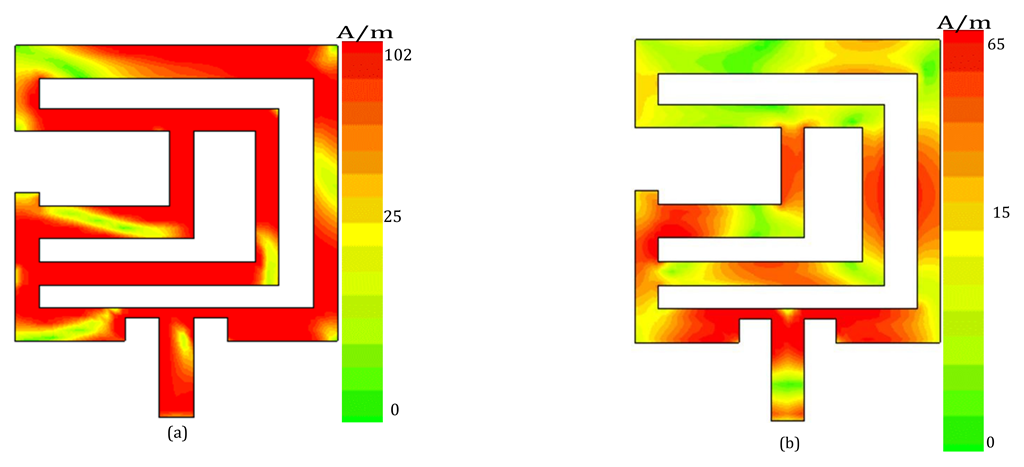
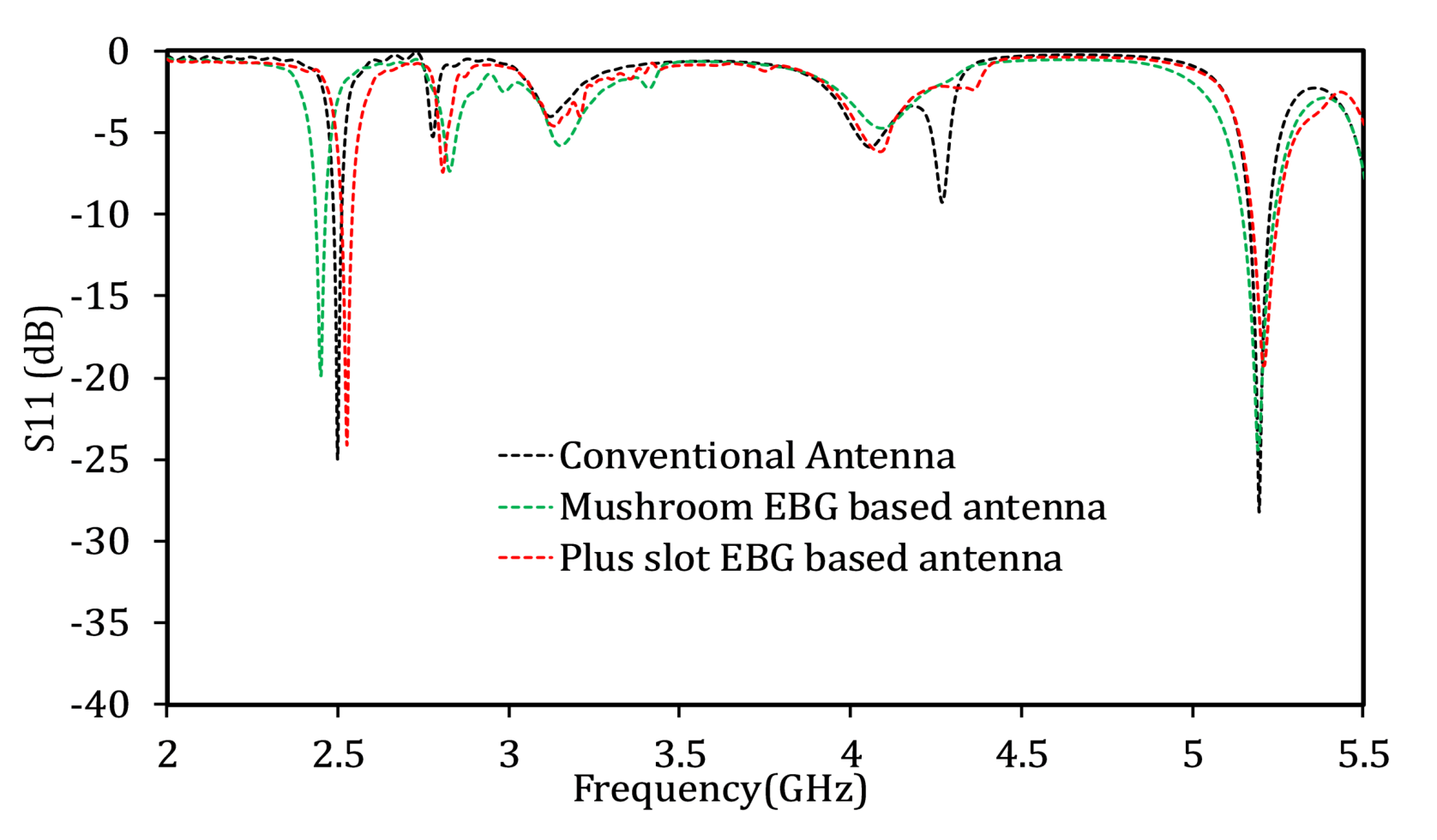
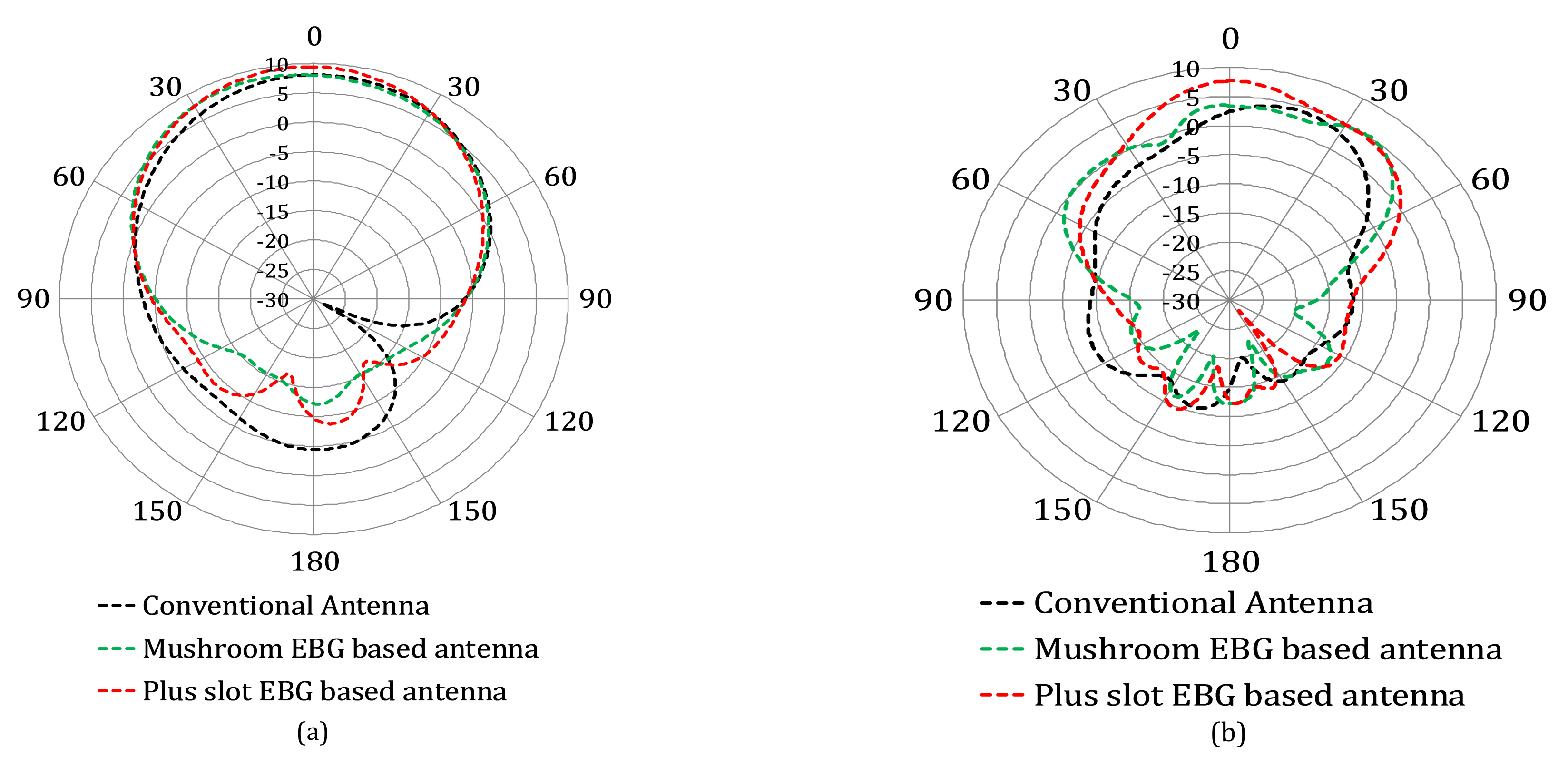
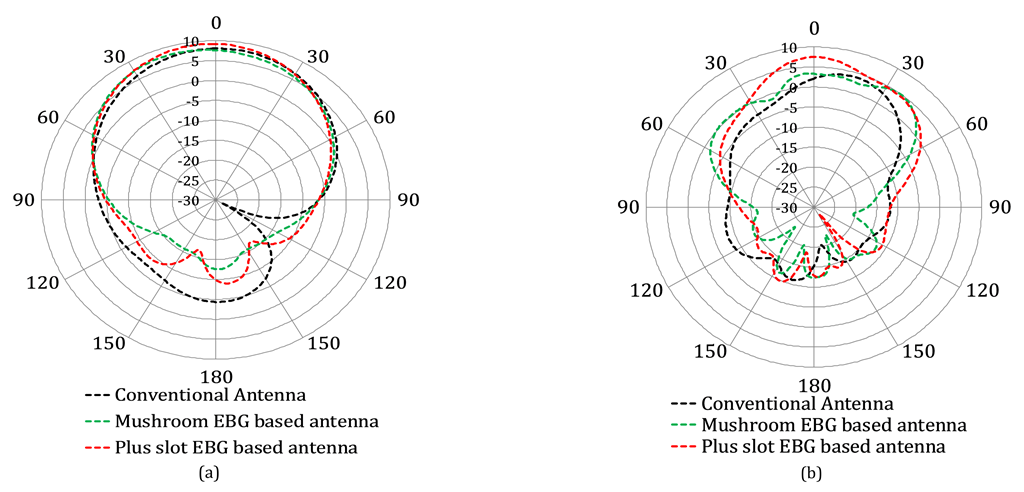
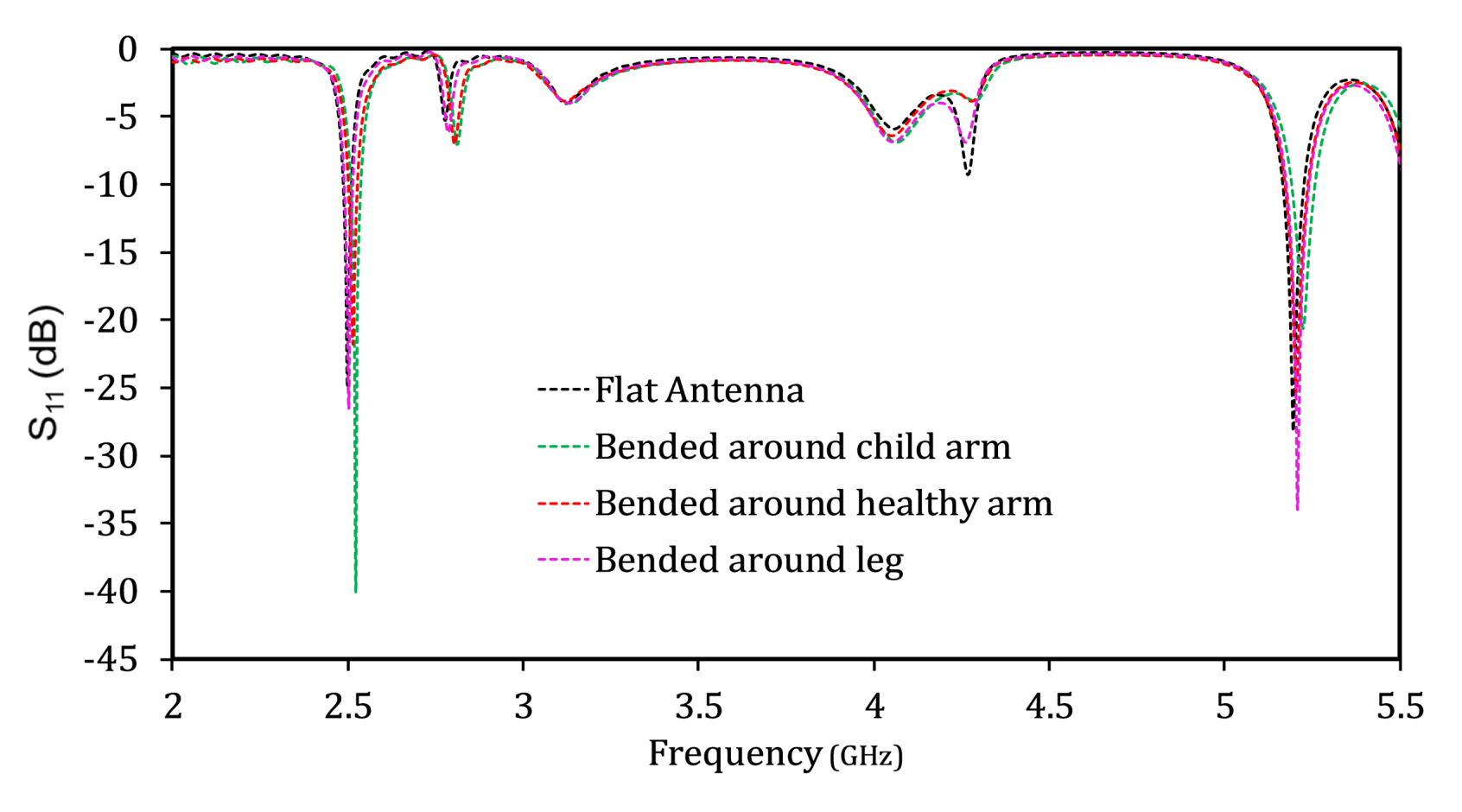
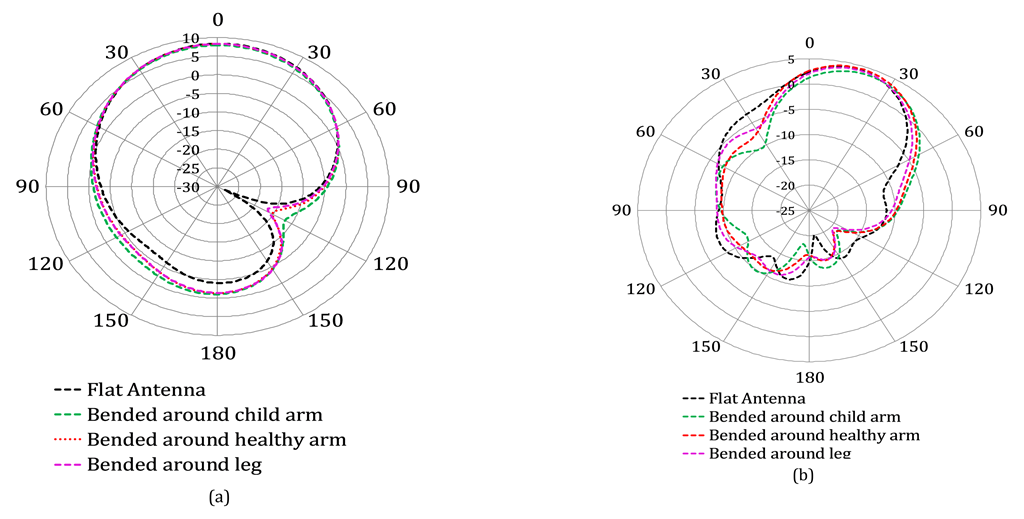
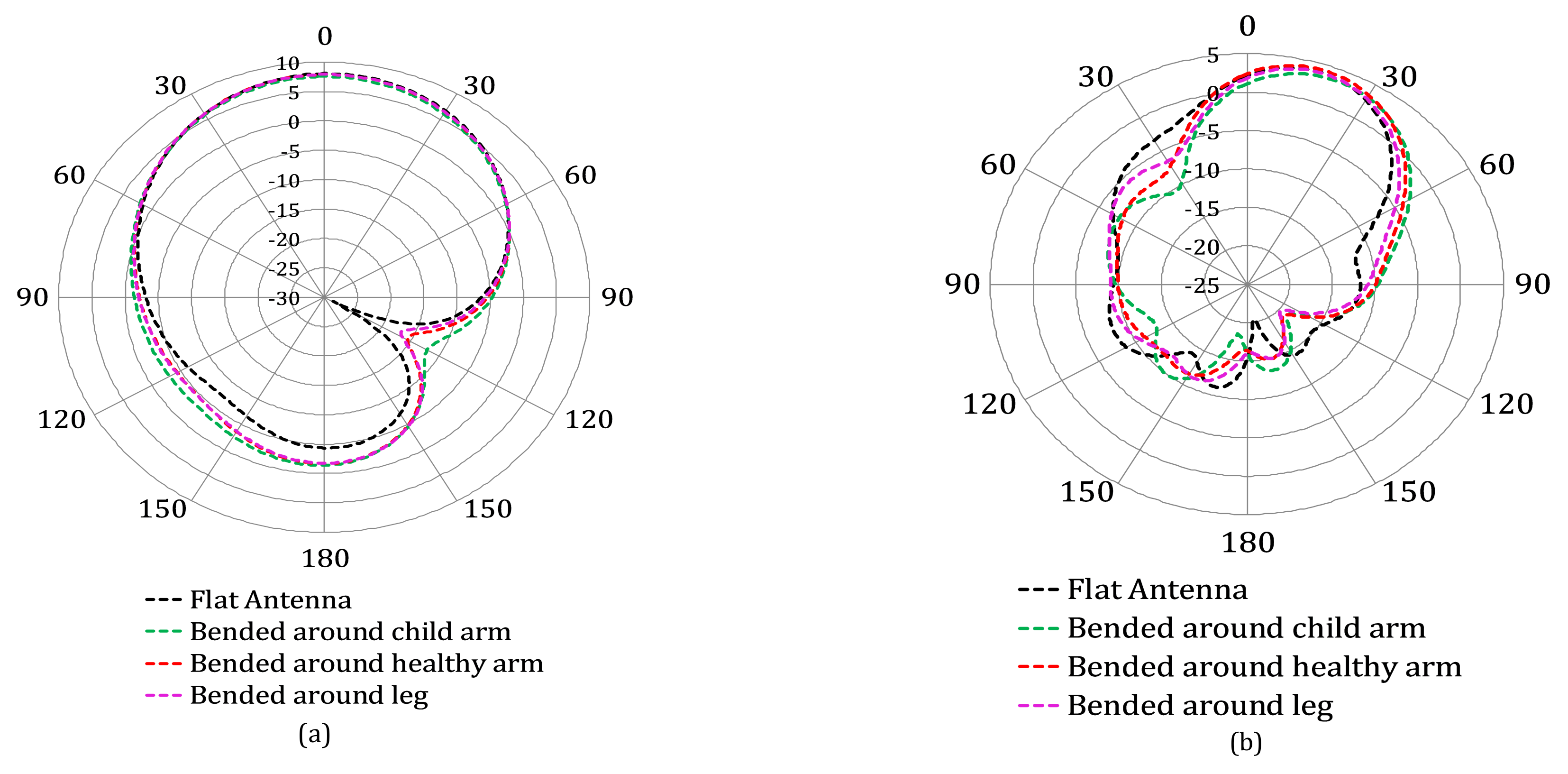
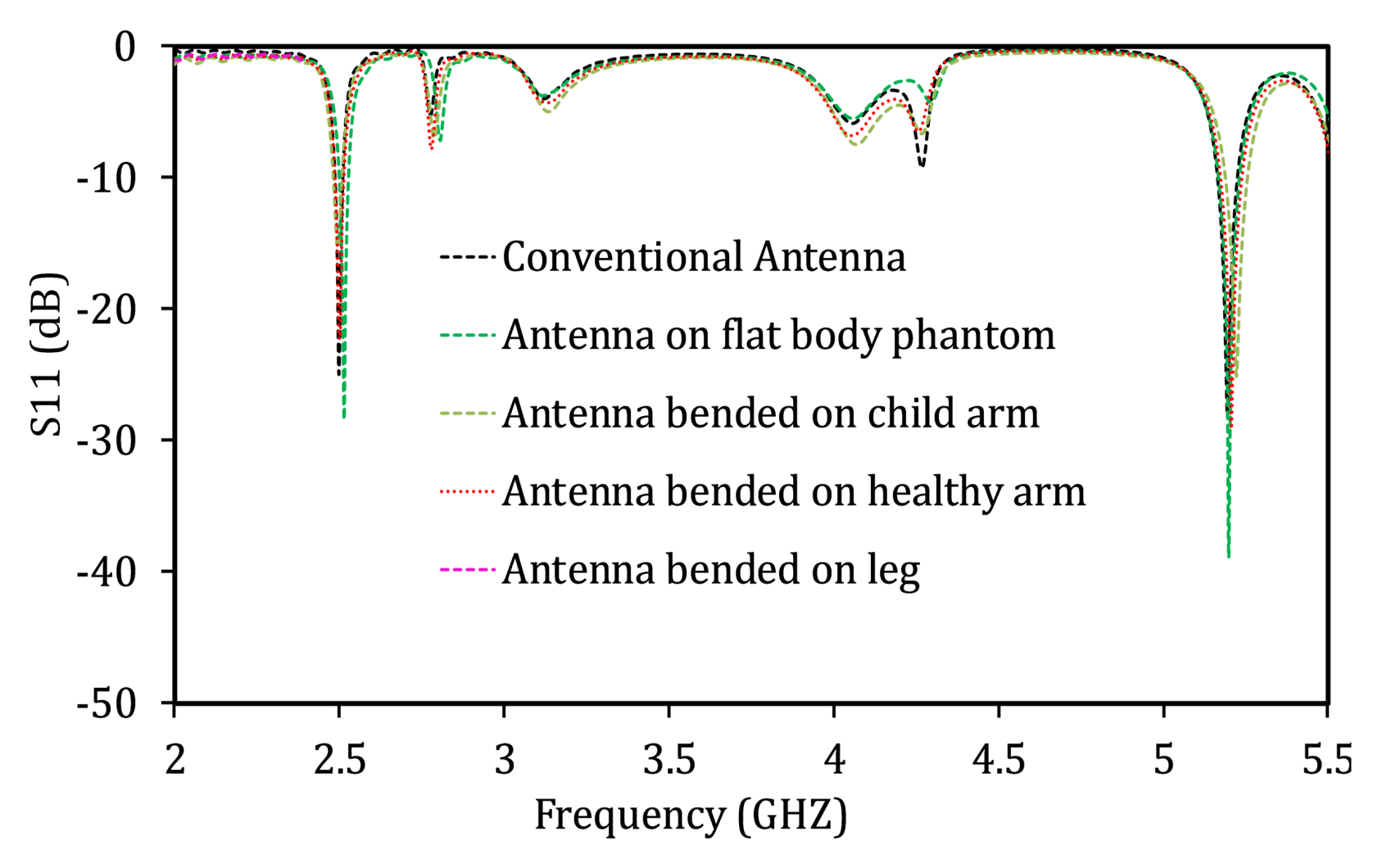


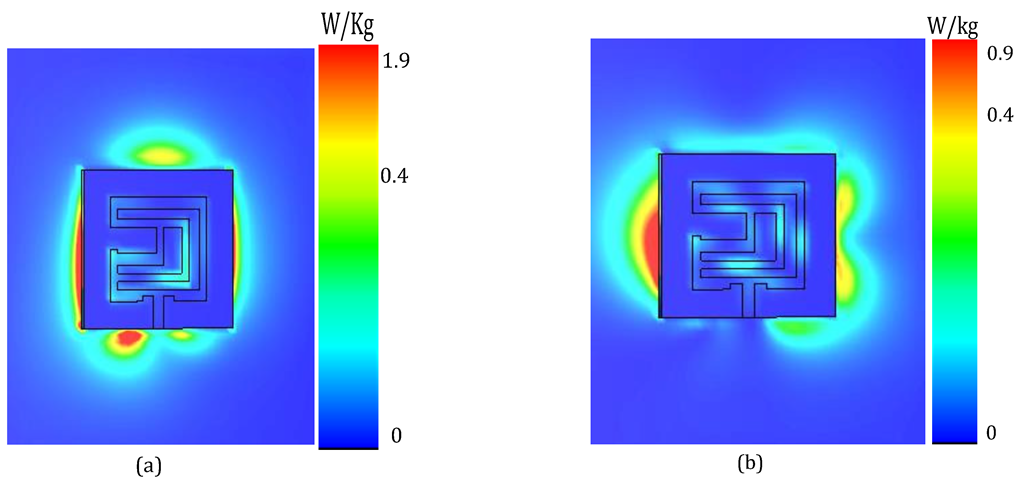
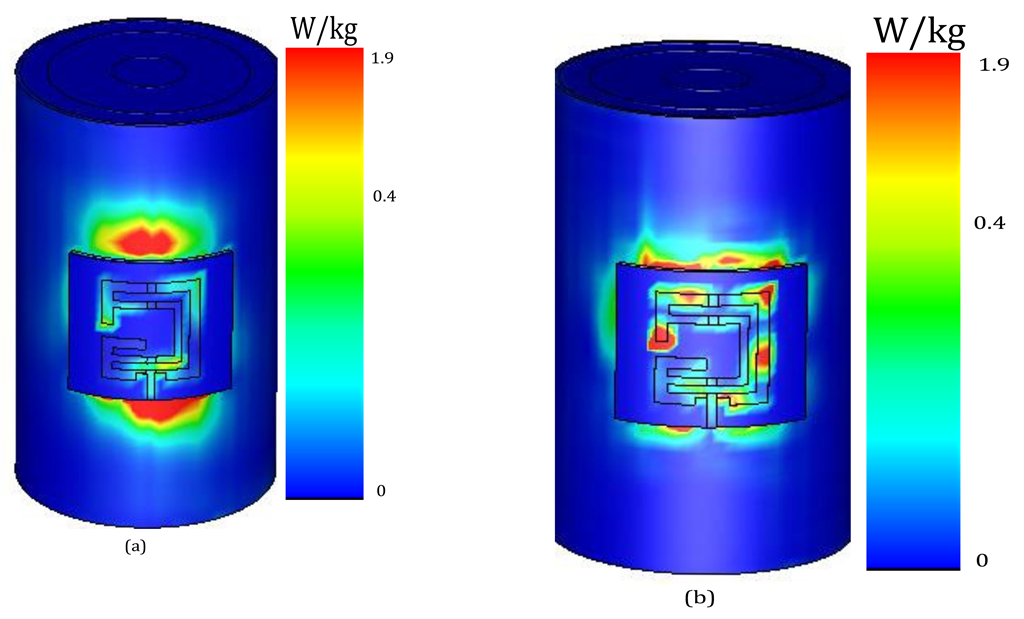
| Parameter | Description | Value (mm) | Parameter | Description | Value (mm) |
|---|---|---|---|---|---|
| ls | Substrate or ground plane length | 68 | g | Gap at sides of the feed line | 5 |
| ws | Substrate or ground plane width | 73 | st | Depth of the gap with the feed line | 3.5 |
| lp | Patch length | 44.75 | c | Right side cut length | 10 |
| wp | Patch width | 47 | w1 | Width of the upper or centered or bottom strip | 5 |
| h | Substrate thickness | 3 | w2 | Width of the right or left side strip | 3.5 |
| mt | Patch or ground plane thickness | 0.03 | w3 | Width of the p shaped cut | 9 |
| lf | Microstrip feed line length | 15.125 | w4 | Width of the I shaped cut | 12 |
| wf | Microstrip feed line width | 5 | l1 | Length of the I shaped cut | 26 |
| Type | lu (mm) | g1 (mm) | g2 (mm) | h (mm) | r (mm) | l (mm) | w (mm) | Periodicity |
|---|---|---|---|---|---|---|---|---|
| Mushroom-like EBG unit cell | 32.5 | 2 | 1.5 | 3 | 1.5 | 32.5 | ||
| Plus-shaped slot EBG unit cell | 26.5 | 0.5 | 1.1 | 3 | 13 | 3 | 26.5 |
| Tissue | Conductivity (2.5 GHz), S/m | /2.5 GHz | Conductivity (5.2 GHz), S/m | /5.2 GHz |
|---|---|---|---|---|
| Bone | 0.38459 | 11.41 | 1.0101 | 9.946 |
| Muscle | 1.705 | 52.79 | 4.2669 | 49.278 |
| Fat | 0.10235 | 5.28 | 0.2547 | 5.0104 |
| Skin | 1.4407 | 38.06 | 3.2185 | 35.61 |
| Parameter | Conventional Dual Band Antenna | Mushroom-like EBG-Based Antenna | EBG with Plus- Shaped Slots- Based Antenna | |||
|---|---|---|---|---|---|---|
| Frequency (GHz) | 2.5 | 5.196 | 2.452 | 5.192 | 2.528 | 5.208 |
| Bandwidth (MHz) | 23.8 | 60.4 | 29 | 94 | 31.7 | 77.1 |
| Return loss (dB) | −24.975 | −28.234 | −19.82 | −24.41 | −24.06 | −19.25 |
| Directivity (dB) | 8.39 | 9.01 | 8.55 | 11.6 | 9.66 | 9.33 |
| Gain (dBi) | 8.08 | 8.74 | 8.43 | 11.4 | 9.43 | 9.14 |
| Radiation Efficiency (%age) | 93.06 | 93.94 | 97.43 | 96.17 | 94.89 | 95.71 |
| Total efficiency (%age) | 92.76 | 93.80 | 96.41 | 95.82 | 94.52 | 94.58 |
| Angular width (Deg) | 83.4 | 76.9 | 80.2 | 99.4 | 62.8 | 70.2 |
| Parameter | Conventional Antenna without Body | Conventional Antenna Bent Around Arm of Radius 40 mm | ||
|---|---|---|---|---|
| Frequency (GHz) | f1 = 2.5 | f2 = 5.196 | f1 = 2.508 | f2 = 5.224 |
| Gain (dBi) | 8.08 | 8.74 | 6.68 | 9.01 |
| Directivity (dB) | 8.39 | 9.01 | 7.7 | 9.29 |
Publisher’s Note: MDPI stays neutral with regard to jurisdictional claims in published maps and institutional affiliations. |
© 2022 by the authors. Licensee MDPI, Basel, Switzerland. This article is an open access article distributed under the terms and conditions of the Creative Commons Attribution (CC BY) license (https://creativecommons.org/licenses/by/4.0/).
Share and Cite
Ahmad, A.; Faisal, F.; Ullah, S.; Choi, D.-Y. Design and SAR Analysis of a Dual Band Wearable Antenna for WLAN Applications. Appl. Sci. 2022, 12, 9218. https://doi.org/10.3390/app12189218
Ahmad A, Faisal F, Ullah S, Choi D-Y. Design and SAR Analysis of a Dual Band Wearable Antenna for WLAN Applications. Applied Sciences. 2022; 12(18):9218. https://doi.org/10.3390/app12189218
Chicago/Turabian StyleAhmad, Ashfaq, Farooq Faisal, Sadiq Ullah, and Dong-You Choi. 2022. "Design and SAR Analysis of a Dual Band Wearable Antenna for WLAN Applications" Applied Sciences 12, no. 18: 9218. https://doi.org/10.3390/app12189218
APA StyleAhmad, A., Faisal, F., Ullah, S., & Choi, D.-Y. (2022). Design and SAR Analysis of a Dual Band Wearable Antenna for WLAN Applications. Applied Sciences, 12(18), 9218. https://doi.org/10.3390/app12189218








